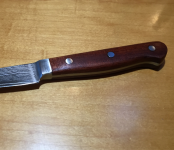I just picked up a knife blank (kit) from Woodcraft. I had promised my daughter to get her a good Chef's Knife as the one she has broke where blade meets handle. The kit i found at WoodCraft is reinforced at that point where flat blade steel meets the handle. I decided I would get the kit and make my own wood handle. I think our daughter wood appreciate that much more than just picking out in the cutlery section of Williams and Sonoma.
My question is: What is the best wood to use for the handle? The part for the handle is full length so the wood would be two pieces with 3 thru rivets.
I have all sorts of scraps to pick from.
The list:
Maple>soft and hard I don't think maple fares so good with water immersion
Spalted Maple NO WAY
Oak/White The white oak is quarter sawn and my first choice at this point
Oak/Red Plain sawn, but on small piece can be quarter sawn. Not as good as W. oak
Black Locust This is very hard but too splintery I think. Splinters can be sharp and long
White Ash great for shovel handles and baseball bats, but i am not so sure for a handle that accidentally goes into dish washer
Pine great for workability, should give her backup pieces so she can make her own [unsure] when the soft wood breaks down. Soak in oil maybe?
Zebra wood interesting but much too splintery
Brazilian walnut Extreme hardness but also prone to splintering along edges. I got scraps of this from a siding job (other contractor on one of my jobs) It seems to have some sort of weather proofing impregnation. Not sure about use around food preparation.
Cherry and Walnut both are favorite woods, but not so sure about using for kitchen ware.
Birch I can probably find a few pieces in the kindling pile
Sasafras I love the smell and also the crackling and sparking when turns to fire wood in fire place. Definitely not for a cutlery handle. Splintery
I am leaning towards White Oak at this point. I am wondering if another wood would be MUCH better. There are dozens of pen or other blanks for small turning projects that I could pick up at woodcraft(I would be doing final shaping with rasps).
Tinker
My question is: What is the best wood to use for the handle? The part for the handle is full length so the wood would be two pieces with 3 thru rivets.
I have all sorts of scraps to pick from.
The list:
Maple>soft and hard I don't think maple fares so good with water immersion
Spalted Maple NO WAY
Oak/White The white oak is quarter sawn and my first choice at this point
Oak/Red Plain sawn, but on small piece can be quarter sawn. Not as good as W. oak
Black Locust This is very hard but too splintery I think. Splinters can be sharp and long
White Ash great for shovel handles and baseball bats, but i am not so sure for a handle that accidentally goes into dish washer
Pine great for workability, should give her backup pieces so she can make her own [unsure] when the soft wood breaks down. Soak in oil maybe?
Zebra wood interesting but much too splintery
Brazilian walnut Extreme hardness but also prone to splintering along edges. I got scraps of this from a siding job (other contractor on one of my jobs) It seems to have some sort of weather proofing impregnation. Not sure about use around food preparation.
Cherry and Walnut both are favorite woods, but not so sure about using for kitchen ware.
Birch I can probably find a few pieces in the kindling pile
Sasafras I love the smell and also the crackling and sparking when turns to fire wood in fire place. Definitely not for a cutlery handle. Splintery
I am leaning towards White Oak at this point. I am wondering if another wood would be MUCH better. There are dozens of pen or other blanks for small turning projects that I could pick up at woodcraft(I would be doing final shaping with rasps).
Tinker


![ScreenClip [1].png](/data/attachments/23/23764-4e8992cf8d6b7fa58830ff2956cf09fa.jpg?hash=qTnx7yGJSS)
